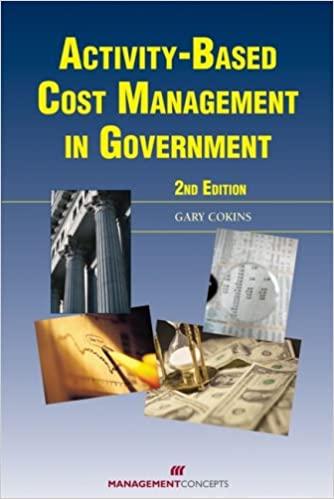Question
Miami Valley Architects Inc. provides a wide range of engineering and architectural consulting services through its three branch offices in Columbus, Cincinnati, and Dayton, Ohio.
Miami Valley Architects Inc. provides a wide range of engineering and architectural consulting services through its three branch offices in Columbus, Cincinnati, and Dayton, Ohio. The company allocates resources and bonuses to the three branches based on the net income of the period. The results of the firms performance for the most recent year follows ($ in thousands):

Miami Valley accumulates overhead items in one overhead pool and allocates it to the branches based on direct labor dollars. For this year, the predetermined overhead rate was $1.859 for every direct labor dollar incurred by an office. The overhead pool includes rent, depreciation, and taxes, regardless of which office incurred the expense. Some branch managers complain that the overhead allocation method forces them to absorb a portion of the overhead incurred by the other offices.
Management is concerned with the recent operating results. During a review of overhead expenses, management noticed that many overhead items were clearly not correlated to the movement in direct labor dollars as previously assumed. Management decided that applying overhead based on activity-based costing and direct tracing wherever possible should provide a more accurate picture of the profitability of each branch.
An analysis of the overhead revealed that the following dollars for rent, utilities, depreciation, and taxes could be traced directly to the office that incurred the overhead ($ in thousands):

Required:
1. What overhead costs should be assigned to each branch based on ABC concepts?

2. What is the contribution of each branch before subtracting the results obtained in requirement 1?

3. What is the profitability of each branch office using ABC?

Activity pools and their corresponding cost drivers were determined from the accounting records and staff surveys as ollows: \begin{tabular}{lrrrr} & Columbus & Cincinnati & Dayton & Total \\ Sales & $1,500 & $1,419 & $1,067 & $3,986 \\ Less: & & & & \\ Direct labor & 382 & 317 & 317 & 1,016 \\ Direct materials & 281 & 421 & 185 & 887 \\ Overhead & 710 & 589 & 589 & 1,888 \\ Net income & $127 & $92 & $(24) & $195 \\ \hline \hline \end{tabular} \begin{tabular}{|c|c|c|c|c|c|} \hline \multicolumn{6}{|c|}{\begin{tabular}{l} Profitability of Each Branch Based on Activity-based Costing \\ (in thousands) \end{tabular}} \\ \hline & Columbus & Cincinnati & Dayton & \multicolumn{2}{|c|}{ Total } \\ \hline Contribution margin & & & & $ & 0 \\ \hline Activity-based overhead & & & & & \\ \hline Operating income(loss) & 0.00 & 0.00 & 0.00 & $ & 0.00 \\ \hline \end{tabular} What overhead costs should be assigned to each branch based on ABC concepts? (Do not round intermediate calculations. Enter your ans thousands of dollars, rounded to two decimal places.)
Step by Step Solution
There are 3 Steps involved in it
Step: 1

Get Instant Access to Expert-Tailored Solutions
See step-by-step solutions with expert insights and AI powered tools for academic success
Step: 2

Step: 3

Ace Your Homework with AI
Get the answers you need in no time with our AI-driven, step-by-step assistance
Get Started


